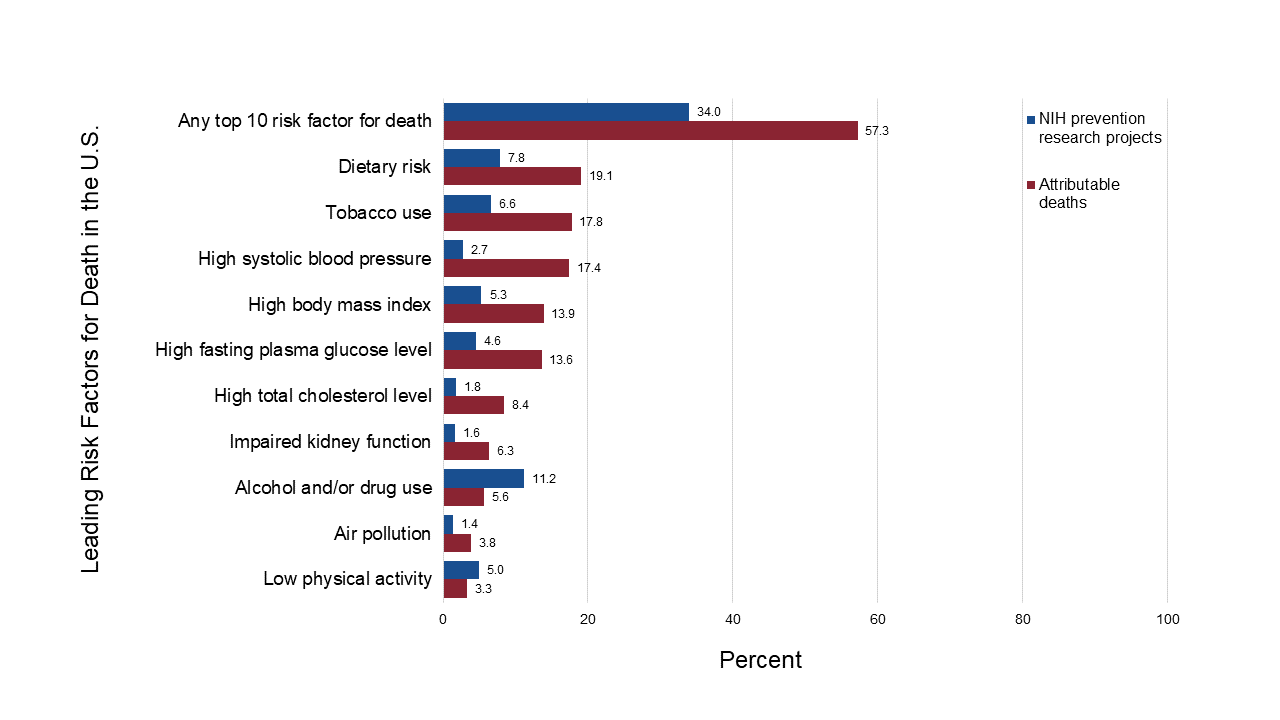You are here
Media Advisory
Friday, November 8, 2019
Study finds leading risk factors and causes of death and disability underrepresented in NIH-supported prevention research
What
A study by National Institutes of Health scientists in the Office of Disease Prevention (ODP) examined NIH grants and cooperative agreements during fiscal years 2012 through 2017 to determine the alignment of prevention research across NIH institutes and centers with leading risk factors and causes of death and disability in the United States. The study found that while the top-10 risk factors for death are associated with more than half of the deaths in the United States, only a third of NIH-supported prevention research measured those risk factors as exposures or outcomes. Similarly, while 7 out of every 10 Americans die from the 10 leading causes of death, fewer than 3 in 10 prevention research projects supported by the NIH measure these causes of death as exposures or outcomes. The study was published today in the journal JAMA Network Open.
The study revealed that most prevention research projects included an observational design or secondary data analysis, while relatively few included a clinical trial focused on preventing the leading risk factors and causes for death. Further, even though it is common for one person to have multiple risk factors (e.g., individuals who smoke also often have a poor diet and engage in little physical activity), few studies took advantage of this pattern to address multiple risk factors at the same time.
The analysis was limited by sampling only the most common types of grant awards and examining only primary and secondary prevention research in humans. The analysis excluded basic, pre-clinical, and clinical research that might eventually lead to prevention research.
This report suggests there is an opportunity for the NIH to better align prevention research with the leading causes and risk factors for death and disability in the United States, particularly by incorporating more clinical trials to evaluate interventions to prevent those risk factors and causes.
Article
Vargas, A.J., Schully, S.D., Villani, J., Ganoza Caballero, L., Murray, D.M., “Assessment of Prevention Research Measuring Leading Risk Factors and causes of Mortality and Disability Supported by the U.S. National Institutes of Health” JAMA Network Open DOI: 10.1001/jamanetworkopen.2019.14718 (Nov. 8, 2019).
Who
- David Murray, Ph.D., Associate Director for Prevention, and Director, Office of Disease Prevention, NIH
- Ashley Vargas, Ph.D., M.P.H, Health Science Policy Analyst, Office of Disease Prevention, NIH
Contact
To schedule an interview, please contact Kat Schwartz, odpmedia@od.nih.gov, 301-827-6541.
About the Office of Disease Prevention (ODP): The ODP is the lead office at the NIH responsible for assessing, facilitating, and stimulating research in disease prevention, and disseminating the results of this research to improve public health. For more information about the ODP, visit prevention.nih.gov.
About the National Institutes of Health (NIH): NIH, the nation's medical research agency, includes 27 Institutes and Centers and is a component of the U.S. Department of Health and Human Services. NIH is the primary federal agency conducting and supporting basic, clinical, and translational medical research, and is investigating the causes, treatments, and cures for both common and rare diseases. For more information about NIH and its programs, visit www.nih.gov.
NIH…Turning Discovery Into Health®

